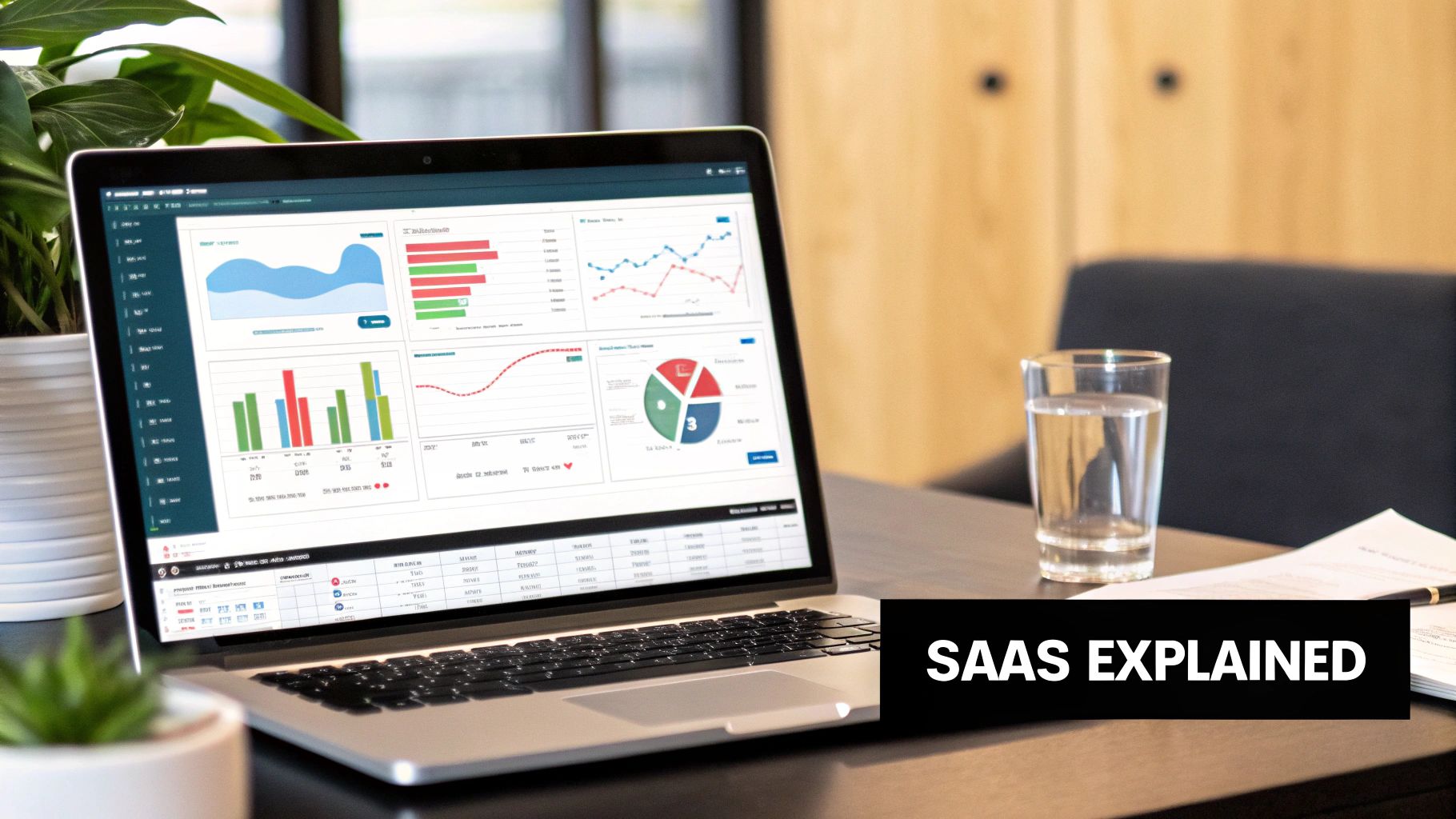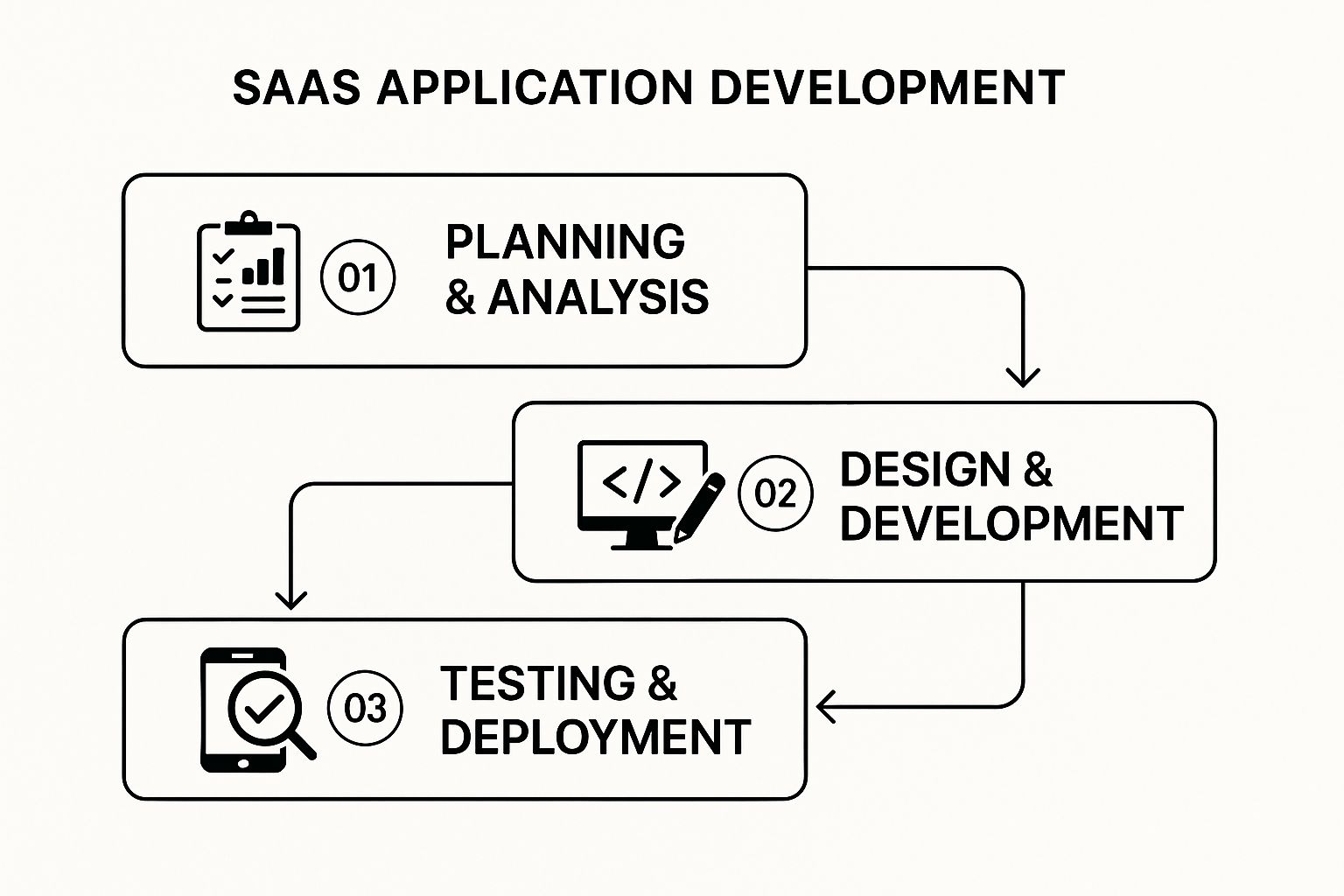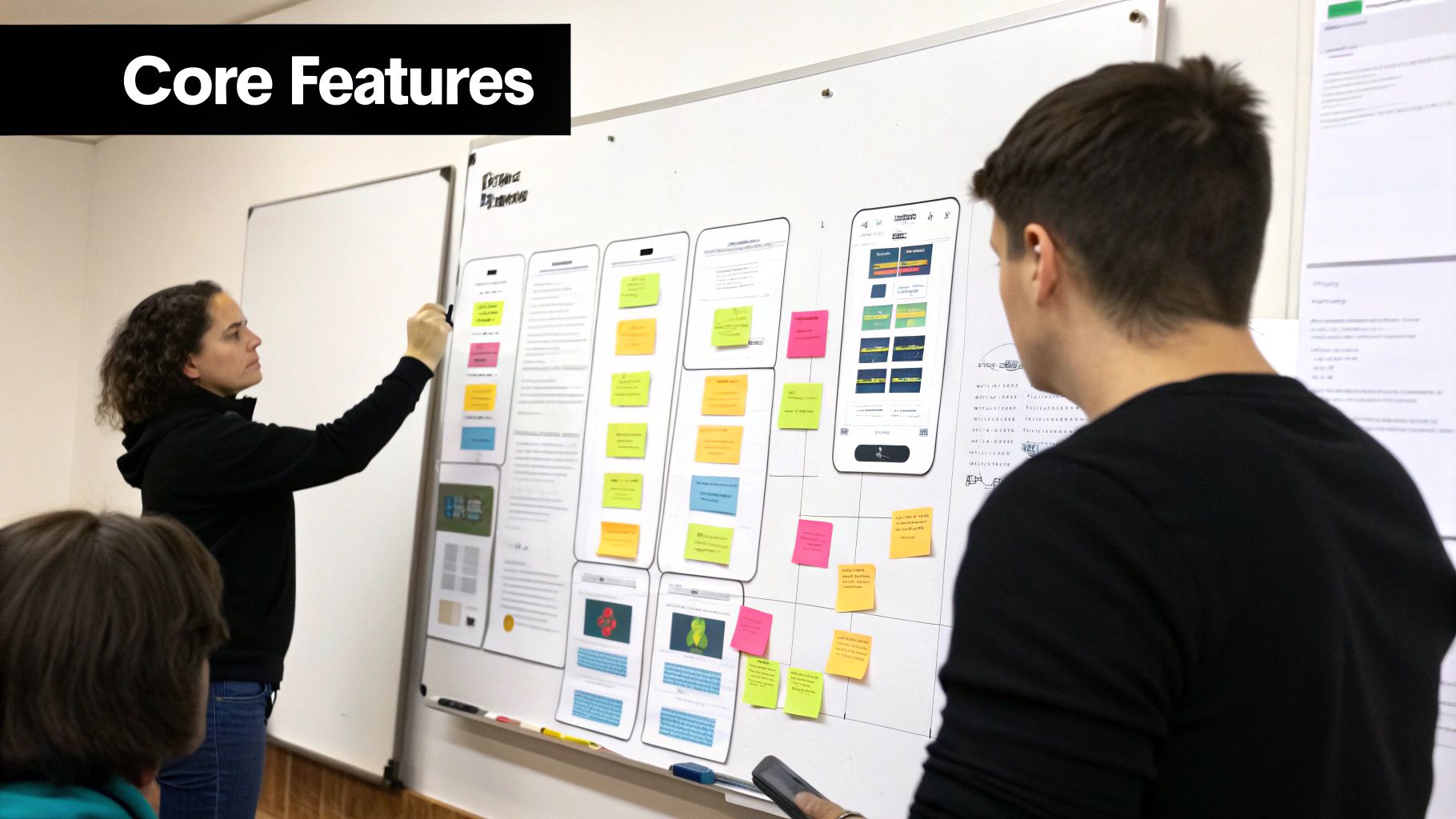SaaS application development services are the professional services that design, build, and maintain software that lives in the cloud. Unlike traditional software you install on a single computer, SaaS is accessed over the internet, typically through a subscription. This model offers a highly flexible and scalable way for modern businesses to operate.
Decoding SaaS: A Fundamental Shift in Business Software

The simplest way to understand Software as a Service (SaaS) is to compare it to streaming a film rather than buying a DVD. With a service like Netflix, you pay a subscription for access to a vast library of content without owning physical discs or managing storage and maintenance. SaaS applies this same proven logic to business software.
Instead of purchasing a software licence upfront and navigating the complexities of installation on every office computer, you subscribe to a service. This service is hosted by a provider on their powerful servers and delivered to your team over the internet, accessible directly from a web browser or a dedicated app.
This model is a significant departure from legacy methods. The old approach involved hefty upfront costs, complex installations, and the continuous burden of managing updates and security patches in-house. SaaS systematically removes these barriers, offering a far more agile and cost-effective methodology.
To put it into perspective, here is a direct comparison of the two models.
Traditional Software vs SaaS At a Glance
As the table illustrates, the SaaS model fundamentally redefines how businesses budget for and utilise software, transforming it from a fixed asset into a flexible, operational utility.
From Ownership to Subscription
This shift from ownership to subscription is more than a technicality; it's a strategic business decision. The global migration towards cloud computing underscores the momentum behind this trend. In fact, the global SaaS market is experiencing explosive growth, a trend reflected in recent SaaS market analysis.
The core principle of SaaS is to transform a product into a service. This paradigm shift enables businesses to concentrate on their core operations rather than managing complex IT infrastructure, turning software from a capital expense into a predictable operational cost.
By opting for a subscription model, companies gain continuous access to the latest features and security updates without any internal effort. This ensures the software evolves in lockstep with your business, preventing it from becoming an obsolete technological liability.
Why Custom SaaS Development Services Matter
While numerous off-the-shelf SaaS products exist (like Trello or Slack), they offer a one-size-fits-all solution. This can be effective, but it may not perfectly align with your unique business processes or provide a distinct competitive advantage. This is where SaaS application development services become a strategic imperative.
Engaging an expert development partner allows you to build a custom solution from the ground up, tailored precisely to your operational needs and strategic objectives. This bespoke approach delivers significant advantages:
- Unique Functionality: Build features that solve your specific problems, creating a genuine competitive advantage.
- Enhanced Scalability: Your system is architected from day one to grow seamlessly with your user base and business ambitions.
- Full Control & Ownership: You retain the intellectual property. You have complete control over the product’s roadmap and future direction.
Partnering with a seasoned development team means you're not just procuring code; you are investing in deep industry expertise. A true partner helps you navigate technical complexities, avoid common pitfalls, and build a durable asset that delivers long-term value and recurring revenue.
The SaaS Development Journey From Idea To Launch
Transforming a concept into a market-ready SaaS application is not magic; it is a structured, methodical process. As seasoned SaaS developers, we have spent decades refining our approach to ensure transparency, quality, and predictability from the initial consultation to the final launch. Consider it analogous to architecture: you wouldn't start laying bricks without a detailed, approved blueprint.
This journey is a genuine partnership, focused on translating your vision into a valuable, tangible asset for your business. Each phase builds logically on the last, culminating in a robust and user-centric product. By understanding this lifecycle, you can have confidence that your project is in experienced hands, progressing with clear milestones and expert guidance.
This visual flow demonstrates how a structured methodology deconstructs a complex project into manageable, sequential phases, ensuring clarity and progress.

As the infographic illustrates, development is far more than just writing code. It is a comprehensive process where strategic planning and rigorous testing are as vital as the design and engineering phases.
Phase 1: The Discovery and Strategy Workshop
Before a single line of code is written, we must get to the heart of your concept. This initial discovery phase is where we align on your business goals, target audience, and the core problem your SaaS will solve. It's about mapping the entire project to prevent costly missteps later.
During this stage, our team collaborates closely with you to:
- Define the Core Value Proposition: We crystallise what makes your idea unique and why customers will choose it over alternatives.
- Identify the Minimum Viable Product (MVP) Scope: We focus on the essential features required for a successful initial launch. This accelerates your time-to-market, allowing you to gather real user feedback faster.
- Analyse Technical Feasibility: Our architects assess the optimal technology stack and architectural approach to ensure your platform is scalable, secure, and future-proof.
This foundational planning establishes a solid framework for everything that follows, creating a clear roadmap that guides the entire project.
Phase 2: UI/UX Design and Prototyping
With a robust strategy in place, the focus shifts to the user. A powerful application is ineffective if people find it confusing or frustrating. The UI/UX (User Interface/User Experience) design phase is dedicated to crafting an intuitive, engaging, and visually appealing experience.
We create interactive wireframes and prototypes, allowing you to see and feel how the application will function before development commences. This iterative process lets us test user flows, refine navigation, and perfect the layout based on your feedback, ensuring the final product is genuinely a pleasure to use. You can explore a more detailed breakdown of how to build a SaaS product in our comprehensive guide.
An exceptional user experience isn't a luxury; it's a core component of customer retention. Research consistently shows that a well-designed UI can raise conversion rates by up to 200%, and a superior UX can boost them by 400%.
Phase 3: Agile Development and Engineering
This is where the architectural blueprints from the design phase are brought to life. Our engineers begin building the application, working within an agile framework. This means we develop the software in short, focused cycles called "sprints," delivering functional pieces of the application regularly.
This methodology offers major advantages:
- Flexibility: It allows us to adapt to changes and incorporate feedback throughout the entire process.
- Transparency: You see tangible progress at the end of each sprint, eliminating surprises.
- Quality: Continuous integration and development practices ensure we maintain high-quality code from start to finish.
Phase 4: Rigorous Quality Assurance and Testing
Before your application meets its first user, it undergoes exhaustive testing. Our Quality Assurance (QA) team acts as your users' greatest advocate, working tirelessly to identify and resolve any issues. Ensuring your SaaS application is robust and reliable is paramount, which is why incorporating rigorous software testing best practices is non-negotiable.
We conduct a full battery of tests—including functional, performance, security, and usability testing—to ensure the application is stable, secure, and performs flawlessly under real-world pressure.
Phase 5: Deployment and Ongoing Support
The launch is merely the beginning of your SaaS journey. We manage the entire deployment process, migrating your application to a live server environment. Our partnership does not end there. We provide ongoing support and maintenance to ensure your platform remains secure, updated, and optimised as your business grows and user needs evolve.
The Architectural Pillars Of A Resilient SaaS Platform

Behind every great SaaS application that simply works is a meticulously planned architecture. It is the technical blueprint, the very foundation that enables your platform to grow, remain secure, and deliver a consistently excellent user experience. While the details can be technical, understanding these core pillars is vital when investing in SaaS application development services.
Think of it like building a skyscraper versus a garden shed. You wouldn't use the same foundation for both. A SaaS platform designed for thousands of concurrent users requires a far more robust architecture than one for a small internal team. Getting this right from day one isn't just a preference; it's essential for long-term success.
This is where an experienced development partner demonstrates their true value. They don't just write code; they design and build a solid foundation capable of supporting your business ambitions for years to come.
The Power of Multi-Tenancy
At the heart of most modern SaaS platforms lies the principle of multi-tenancy. The easiest analogy is an apartment building. The building itself—the plumbing, electricity, and main structure—is shared by all residents. However, each tenant has their own private, secure apartment inside.
A multi-tenant SaaS architecture functions in precisely the same way. A single instance of the software and its underlying infrastructure (like databases and servers) serves multiple customers, or "tenants." Crucially, each tenant's data is kept completely isolated and invisible to others, guaranteeing privacy and security.
This approach yields significant advantages:
- Cost-Effectiveness: Sharing infrastructure is far more economical than building and maintaining a separate instance for every customer.
- Easier Maintenance: When an update is required, it is applied once to the central application, and every tenant benefits instantly.
- Efficient Onboarding: New customers can be provisioned and granted access almost instantly because the core infrastructure is already in place.
Multi-tenancy is the architectural engine that makes the SaaS business model so efficient and scalable. It allows providers to serve a large customer base from a unified platform, translating directly into better economies of scale and a more sustainable service.
Designing for Unrestricted Scalability
Scalability is your SaaS application's ability to handle growth without performance degradation. If your user base suddenly expands from 100 to 100,000, a scalable system will accommodate this seamlessly. An unscalable one will slow to a crawl, crash, and ultimately drive away your hard-won users.
True scalability cannot be bolted on as an afterthought; it must be woven into the application's fabric from the very beginning. This involves making intelligent decisions about the technology stack, database design, and server infrastructure. The objective is to build a system that can grow in two primary ways:
- Vertical Scaling: Increasing the resources of existing servers (e.g., adding more memory or processing power).
- Horizontal Scaling: Adding more servers to distribute the load.
Modern cloud platforms like AWS and Azure are indispensable here, offering tools that enable applications to scale up or down automatically based on real-time demand. The entire SaaS development lifecycle must account for scalability at every stage, from initial design to final deployment.
Security as a Foundational Layer
In the SaaS world, security is not just another feature—it is the absolute bedrock of trust between you and your customers. A single data breach can inflict irreparable damage on your reputation and business. Therefore, building a digital fortress around your application and its data is non-negotiable.
This extends far beyond strong passwords. A comprehensive SaaS security strategy involves:
- Data Encryption: Protecting data both when it is stored (at rest) and when it is transmitted over the internet (in transit).
- Access Control: Implementing strict roles and permissions so users can only access the information they are authorised to see.
- Regular Security Audits: Proactively identifying and remediating vulnerabilities to stay ahead of potential threats.
- Compliance: Adhering to regulations like GDPR to safeguard user privacy.
When evaluating architectural options, understanding modern deployment strategies provides insight into a provider's expertise. For example, proficiency in implementing SaaS self-hosting on AWS with Terraform demonstrates the technical acumen required to build a secure, scalable environment. These decisions signal a commitment to building a platform that delivers genuine long-term value and reliability.
Choosing Your SaaS Monetisation Strategy
A brilliant product with a flawless architecture is only half the battle. The other, equally critical, half is devising how to convert your user base into a sustainable revenue stream. This is not just about setting a price; it's a strategic decision that directly impacts customer acquisition, retention, and the commercial viability of your platform.
As your development partner, we consider understanding these models a core component of building a successful SaaS application. The right strategy perfectly aligns your product's value with how customers pay for it, creating a win-win scenario. An incorrect strategy, however, can stifle growth before it even begins.
Let's examine the most common and effective SaaS pricing models.
Flat-Rate Pricing
Flat-rate pricing is the essence of simplicity. You offer one product, one set of features, and one price. It is a "one-size-fits-all" monthly or annual subscription, making it incredibly easy for customers to understand and for your business to manage.
This approach works best for products with a highly focused feature set, where multiple tiers would create unnecessary complexity. The primary drawback is its inability to cater to different user segments. A small business and a large enterprise pay the same price, meaning you might leave money on the table with larger clients or price out smaller ones.
Tiered Pricing
This is arguably the most prevalent model in the SaaS industry, and for good reason. Tiered pricing involves offering several packages, or "tiers," at different price points. Each successive tier typically unlocks more features or higher usage limits.
Tiered pricing allows you to serve a much broader audience by aligning value with cost. It establishes a clear upgrade path, naturally encouraging users to move to higher-priced plans as their needs evolve and they become more invested in your platform.
For example, a "Basic" tier might be ideal for a startup, while an "Enterprise" tier could offer the advanced security and support a large corporation requires. The challenge lies in defining these tiers carefully to avoid confusion and ensure each one provides clear, distinct value.
To provide a clearer understanding of how these models compare, here is a quick overview.
Comparison of Common SaaS Pricing Models
This overview of different SaaS monetisation strategies, their benefits, and ideal use cases will help you select the right model for your business.
Choosing the right model is a foundational decision that will influence your product's trajectory from day one. It is about finding the optimal balance between customer value and business sustainability.
Usage-Based and Per-User Pricing
These models tie cost directly to consumption.
- Usage-Based Pricing: Also known as pay-as-you-go, this model charges customers based on their consumption. This is common for infrastructure services like Amazon Web Services (AWS), where you pay for the computing power or data storage you use. It is perceived as fair and scales perfectly with the customer's needs.
- Per-User Pricing: Here, the price is determined by the number of people on a team using the software. Slack is a classic example. This model is straightforward for customers to understand and scales predictably as a company grows.
The Freemium Model
The "Freemium" model offers a basic version of your product completely free of charge, with the goal of converting a percentage of free users into paying customers who desire premium features. It is an extremely powerful marketing tool for driving user adoption and building a massive user base quickly.
However, it requires a delicate balance. The free version must be useful enough to attract and retain users, yet limited enough to provide a compelling reason to upgrade. Supporting a large base of free users also incurs significant infrastructure costs, so a clear and effective conversion pathway is absolutely essential.
Once your SaaS platform is operational, remember that while your monetisation strategy is the engine, a great marketing plan is the fuel. Developing effective SaaS lead generation strategies is vital for sustainable growth.
How To Choose The Right SaaS Development Partner
Selecting a partner for your SaaS application development services is arguably the single most critical decision you will make for your project. It has a greater impact on your success than the technology stack, your pricing model, or even your initial marketing strategy.
A correct choice means your partner becomes a true extension of your team. An incorrect choice can lead to missed deadlines, spiralling costs, and a product that fails to meet your vision.
The market is saturated with agencies, making it easy to be swayed by a low price or a persuasive sales pitch. However, true expertise lies deeper—in a company’s history, their development philosophy, and their commitment to being a genuine partner in your success. Let’s walk through a definitive checklist to help you identify a team that can transform your idea into a market-leading product.
Scrutinise Their Portfolio and Proven Experience
First and foremost, look beyond sales rhetoric for concrete proof. A potential partner's portfolio is their professional history, and it requires more than a cursory glance. Dive deep into their case studies.
You are seeking answers to very specific questions:
- Have they successfully built and launched SaaS platforms before? General web development is fundamentally different from engineering a complex, scalable, multi-tenant SaaS application.
- Do they understand your industry? While not always a prerequisite, a partner who comprehends the unique challenges or compliance requirements of your sector (e.g., FinTech, HealthTech) brings invaluable insight.
- Can they demonstrate tangible results? Look for case studies that quantify user growth, revenue generated, or specific business problems they solved. This indicates they build products with commercial success in mind, not just technical completion.
A strong portfolio is not merely a gallery of screenshots; it is a documented track record of delivering SaaS products that perform and succeed in the real world. If a firm cannot show relevant past projects, they may be learning on your time and budget.
Assess Their Development Methodology and Transparency
How a company builds software is as important as what they build. You should seek a process that is transparent, collaborative, and adaptable. The Agile development methodology is the industry standard for a reason—it is built around flexibility, continuous communication, and incremental progress.
A partnership founded on transparency is a partnership destined for success. You should have complete visibility into project progress at all times, with clear communication channels and no surprises. This is not a "nice-to-have"; it is a fundamental requirement for a healthy collaboration.
This means you must ask how they manage projects. Do they use tools like Jira or Trello? How frequently can you expect meetings and progress reports? A premier partner will welcome these questions and provide clear, confident answers. You need a team that operates with full transparency, not one that works behind a curtain.
For a deeper dive, our guide on how to find the right app developer for your start-up offers additional valuable tips.
Verify Their Technical Expertise and Future-Proofing
A reliable SaaS platform is built upon a foundation of deep technical expertise. Your partner must be proficient in building systems that are scalable, secure, and maintainable. This is a common point of failure for many businesses.
Even in challenging economic climates, the right technology attracts investment. Despite sluggish GDP growth (0.1%) and rising inflation (2.8%) in early 2025, the UK's venture capital scene for SaaS remained surprisingly robust, seeing a deal value of approximately £4.4 billion in Q1 2025 alone, with AI and fintech leading the charge. You can explore these UK SaaS funding trends on developmentcorporate.com.
This data tells a clear story: investors back companies with rock-solid technical foundations. That means you need a partner who can:
- Justify their technology choices: They shouldn't just name a programming language or cloud provider; they should explain why it’s the optimal choice for your project's specific requirements.
- Demonstrate security know-how: Ask them how they approach data encryption, access control, and compliance with regulations like GDPR.
- Plan for scale: They should be architecting for 100,000 users from day one, not just the first 100.
Ultimately, choosing a SaaS development partner is about finding a team that understands your vision and possesses the proven experience to execute it flawlessly. It is a search for a long-term collaborator who will be as invested in your product's success as you are.
Where Do You Go From Here?

We have covered extensive ground in this guide, from initial strategy to the technical architecture that underpins a successful software-as-a-service platform. It is evident that success requires a synthesis of intelligent strategy and deep technical expertise. The path is well-defined, but it takes an experienced partner to transform a great concept into a market-leading product.
We have highlighted the critical decision points that can make or break a project. This underscores the value of experience when navigating the complexities of modern software development. You have seen how a structured, phased process—from discovery to deployment—is the key to creating a robust and scalable platform.
Turning Ideas Into Action
This guide has provided you with a solid educational foundation, but true progress begins when you apply this knowledge to your own vision. Every market-leading SaaS product began with a conversation—a moment where abstract ideas were translated into a concrete plan. The next step is not a sales pitch; it is a strategic dialogue about the opportunity before you.
A true partnership begins when all parties are aligned towards a common goal. It involves us bringing our two decades of experience in building and scaling SaaS ventures to the table and aligning it with your specific challenges and ambitions.
This is where your journey truly begins. We invite you to have a discussion with our team of SaaS experts. It is an opportunity to:
- Discuss your vision in a professional, no-obligation environment.
- Consult with specialists who have navigated similar challenges many times before.
- Understand precisely how our experience in providing saas application development services can bring your concept to fruition.
Let’s begin a conversation focused on building the future of your business. The insights from this guide are the perfect starting point. Together, we can map out the practical steps to bring your innovative idea to life.
Frequently Asked Questions
Considering SaaS application development inevitably raises questions, particularly around cost, timelines, and ownership. This is entirely normal. With decades of experience in this field, we have heard them all, and we believe in providing clear, straightforward answers to help you make informed decisions for your business.
Here are some of the most common queries we address.
How Much Does It Cost To Develop A SaaS Application?
This is a primary question, and the honest answer is: it varies significantly. The cost is contingent on the complexity of your concept, the required features, and the technology stack used. A simple Minimum Viable Product (MVP) could start from approximately £40,000. Conversely, a complex, enterprise-grade platform with numerous third-party integrations can easily exceed £250,000.
Key cost drivers include:
- The number of custom-built features.
- The complexity of API integrations (e.g., payment gateways, CRMs).
- The necessity for stringent security and regulatory compliance, such as GDPR or HIPAA.
- The extent of bespoke UI/UX design and customisation.
This is why we always commence with a detailed discovery phase. It is the only way to provide an accurate estimate that is genuinely tailored to your business needs and objectives.
How Long Does It Take To Build A SaaS Application?
Similar to cost, the timeline can vary widely. A focused MVP can typically be designed, built, and launched within 4-6 months. However, a more advanced application with sophisticated features and robust security may require 9 to 18 months, or sometimes longer.
We are strong proponents of the agile development methodology. It enables us to release an initial version to the market much faster and then iterate based on user feedback. This approach allows you to begin gathering real-world data sooner, reducing initial risk and accelerating the learning curve of what your customers truly value.
Who Owns The Intellectual Property Of The SaaS Application?
This is a critical point on which you should never compromise. When you partner with a reputable development firm like ours, you—the client—retain 100% of the intellectual property (IP) rights. This encompasses the source code, design assets, and all other materials created specifically for your project.
This must be explicitly stated in your contract. While we may leverage our own pre-existing tools or internal frameworks to enhance efficiency, the final, bespoke product is entirely your asset. Always ensure IP ownership is confirmed in writing before any work begins.
What Is The Difference Between An MVP And A Full-Featured SaaS Product?
An MVP, or Minimum Viable Product, is the most streamlined, essential version of your application. It is designed to perform one function exceptionally well: solving a core problem for your target customers. The primary objective is to launch quickly, validate your business hypothesis with real users, and gather invaluable feedback without a massive upfront investment.
A full-featured product is what your SaaS evolves into after the MVP stage. It is the result of continuous development, informed by the data and insights gathered from your initial user base. It will possess a broader range of features, a more polished design, enhanced performance, and the capacity to support a larger number of users. Starting with an MVP is not a trend; it is the most intelligent and effective strategy for building a successful SaaS product today.
Ready to turn your SaaS vision into a market-leading reality? The team at Make IT Simple has over twenty years of experience building scalable platforms that drive growth and generate revenue. Let's have a strategic conversation about your project.


